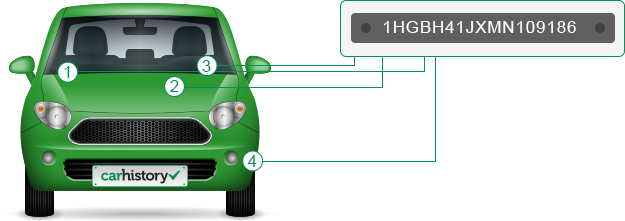
The vehicle identification number (VIN) is composed of 17 characters (digits and capital letters) that act as a unique identifier for the vehicle. A VIN displays the car's unique features, specifications and manufacturer.
The VIN can be found in a couple of places including on the car's registration label (1), on the compliance plate in the engine bay (2) or on the passenger side windshield (3), or on one of the door posts (where the door latches when it is closed) (4). See the image below:
One of your primary concerns when buying a used car, or any car for that matter, should be safety. Sure, that old-school convertible may look cool, but when you're zipping down the highway at 100 kph, you want the assurance that you and any passengers are protected as much as possible in the event of an accident.
Fortunately, car manufacturers have continued to push the boundaries of safety technology over the past decades, creating vehicles that are far more safe to drive than those used in our grandparents' days.
Here's what you should keep an eye out for when it comes to choosing a reliable and safe used car.
ANCAP insights
One way to get an insight into the safety of a car is by checking it's rating from the Australian New Car Assessment Program, also known as ANCAP. The independent organisation gathers data on a broad range of current cars and models from previous years, accumulating in a star rating out of five so that consumers can make an informed choice.
You'll find the ANCAP rating of a car you're interested in as part of your comprehensive CarHistory report, alongside potential information on financial encumbrance and potential odometer rollback. Getting yours is simple, all you need is a car's vehicle identification number (VIN) and you're good to go.
Active vs. passive technology
Traditional 'passive' safety measures such as seatbelts and airbags are standard features these days, having saved countless lives since they were first introduced. In 2009, the Centers for Disease Control and Prevention estimates that the seatbelt saved some 13,000 lives in one year alone1.
Now new active safety features are being introduced to Australia's fleet, encompassing technology that helps to prevent collisions occurring in the first place by predicting and sensing oncoming hazards.
These come in the form of Autonomous Emergency Braking (AEB), as well as reversing cameras and other sensors to help drivers stay safe on the roads.
With almost half (45 per cent) of all collisions down to a single car2, and human error contributing to 90 per cent of crashes3, ANCAP argues that active safety features should be a standard offering on all cars in Australia.
If you are looking to save on your next vehicle by purchasing used, you're more likely to find these safety features in cars from the last five years, so it's well worth keeping an eye out for them.
1CDC, Policy Impact: Seat Belts. Accessed September, 2015.
2ANCAP, Quick Fact: Quick Fact: 45% of fatal crashes involve a single vehicle. Accessed September, 2015.
3ANCAP, Quick Fact: 90% of all crashes involve some form of human error. Accessed September, 2015.